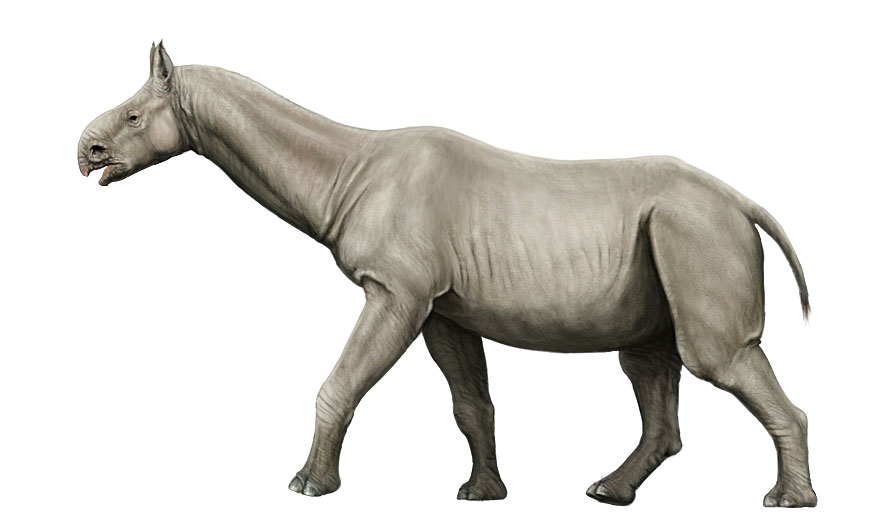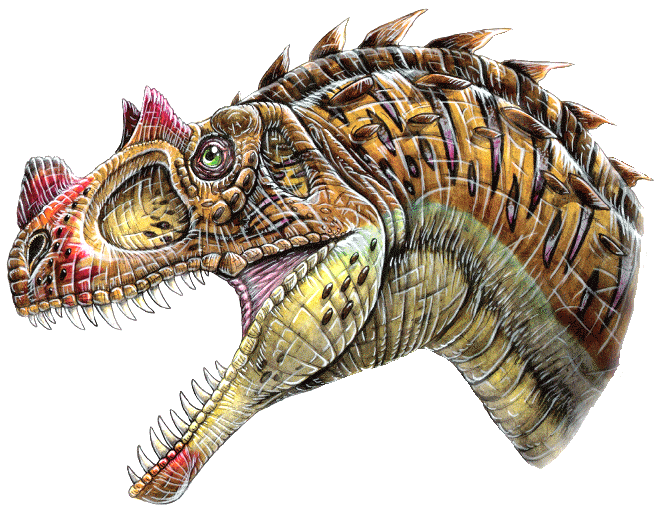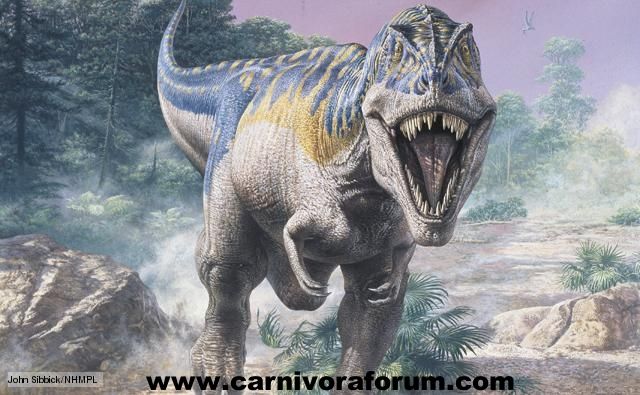Post by Deinobrontornis on Oct 17, 2011 10:29:04 GMT -5
Paraceratherium

Paraceratherium, also commonly known as Indricotherium or Baluchitherium, is an extinct genus of gigantic hornless rhinoceros-like mammals endemic to Eurasia and Asia during the Eocene to Oligocene 37.2—23.030 Mya.
Paraceratherium is the largest land mammal known, larger than the largest species of mammoths (Mammuthus sungari, which may have approached it in size and weight). It is also known as the "giraffe rhinoceros". Adult Paraceratherium are estimated to have been 5.5 meters (18 ft) tall at the shoulder, 9 meters (30 ft) in length from nose to rump, a maximum raised head height of about 8 meters (26 ft), and a skull length of 1.5 metres (4.9 ft). Weight estimates vary greatly, but most realistic and reliable weight estimates are about 20 tonnes. This puts it in the weight range of some medium-sized sauropod dinosaurs.
It was a herbivore that stripped leaves from trees with its down-pointing, tusk-like upper teeth that occluded forward-pointing lower teeth. It had a long, low, hornless skull and vaulted frontal and nasal bones. Its front teeth were reduced to a single pair of incisors in either jaw, but they were conical and so large that they looked like small tusks. The upper incisors pointed straight downwards, while the lower ones jutted outwards. The upper lip was evidently extremely mobile. The neck was very long, the trunk robust, and the limbs long and thick, column-like.
Its type of dentition, its mobile upper lip and its long legs and neck indicate that it was a browser that lived on the leaves and twigs of trees and large shrubs.
Apatosaurus

Apatosaurus, also known by the popular but scientifically redundant synonym Brontosaurus, is a genus of sauropod dinosaur that lived from about 154 to 150 million years ago, during the Jurassic Period (Kimmeridgian and early Tithonian ages). It was one of the largest land animals that ever existed, with an average length of 23 m (75 ft) and a mass of at least 23 metric tons (25 short tons). The composite term Apatosaurus comes from the Greek names apate (ἀπάτη)/apatelos (ἀπατηλός) meaning "deception"/"deceptive" and sauros (σαῦρος) meaning "lizard"; thus, "deceptive lizard". Othniel Charles Marsh gave it this name because he regarded the chevron bones as similar to those of some mosasaurs, members of a group of prehistoric marine lizards.
The cervical vertebrae were less elongated and more heavily constructed than those of Diplodocus and the bones of the leg were much stockier (despite being longer), implying a more robust animal. The tail was held above the ground during normal locomotion. Like most sauropods, Apatosaurus had only a single large claw on each forelimb, with the first three toes on the hind limb possessing claws.

Paraceratherium, also commonly known as Indricotherium or Baluchitherium, is an extinct genus of gigantic hornless rhinoceros-like mammals endemic to Eurasia and Asia during the Eocene to Oligocene 37.2—23.030 Mya.
Paraceratherium is the largest land mammal known, larger than the largest species of mammoths (Mammuthus sungari, which may have approached it in size and weight). It is also known as the "giraffe rhinoceros". Adult Paraceratherium are estimated to have been 5.5 meters (18 ft) tall at the shoulder, 9 meters (30 ft) in length from nose to rump, a maximum raised head height of about 8 meters (26 ft), and a skull length of 1.5 metres (4.9 ft). Weight estimates vary greatly, but most realistic and reliable weight estimates are about 20 tonnes. This puts it in the weight range of some medium-sized sauropod dinosaurs.
It was a herbivore that stripped leaves from trees with its down-pointing, tusk-like upper teeth that occluded forward-pointing lower teeth. It had a long, low, hornless skull and vaulted frontal and nasal bones. Its front teeth were reduced to a single pair of incisors in either jaw, but they were conical and so large that they looked like small tusks. The upper incisors pointed straight downwards, while the lower ones jutted outwards. The upper lip was evidently extremely mobile. The neck was very long, the trunk robust, and the limbs long and thick, column-like.
Its type of dentition, its mobile upper lip and its long legs and neck indicate that it was a browser that lived on the leaves and twigs of trees and large shrubs.
Apatosaurus

Apatosaurus, also known by the popular but scientifically redundant synonym Brontosaurus, is a genus of sauropod dinosaur that lived from about 154 to 150 million years ago, during the Jurassic Period (Kimmeridgian and early Tithonian ages). It was one of the largest land animals that ever existed, with an average length of 23 m (75 ft) and a mass of at least 23 metric tons (25 short tons). The composite term Apatosaurus comes from the Greek names apate (ἀπάτη)/apatelos (ἀπατηλός) meaning "deception"/"deceptive" and sauros (σαῦρος) meaning "lizard"; thus, "deceptive lizard". Othniel Charles Marsh gave it this name because he regarded the chevron bones as similar to those of some mosasaurs, members of a group of prehistoric marine lizards.
The cervical vertebrae were less elongated and more heavily constructed than those of Diplodocus and the bones of the leg were much stockier (despite being longer), implying a more robust animal. The tail was held above the ground during normal locomotion. Like most sauropods, Apatosaurus had only a single large claw on each forelimb, with the first three toes on the hind limb possessing claws.















